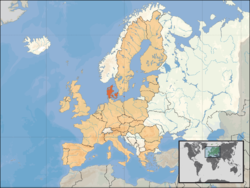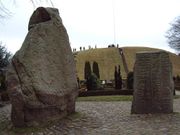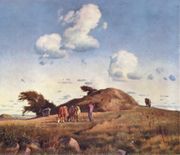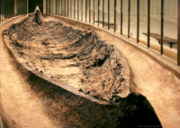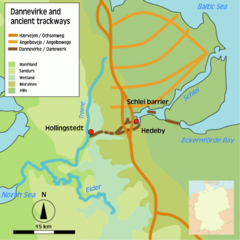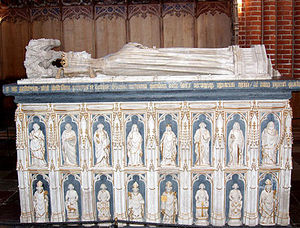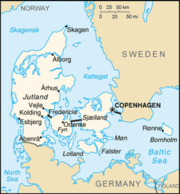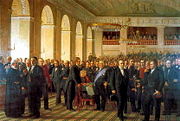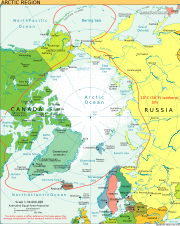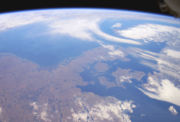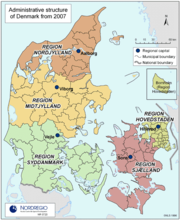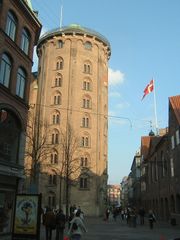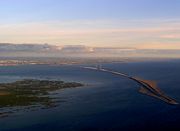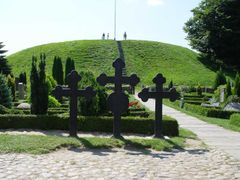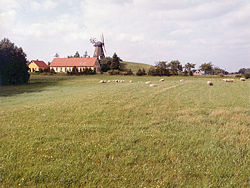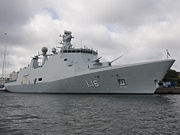Denmark
2008/9 Schools Wikipedia Selection. Related subjects: Europe; European Countries
| Kongeriget Danmark Kingdom of Denmark
|
||||||
|---|---|---|---|---|---|---|
|
||||||
| Motto: none ( Royal motto: Guds hjælp, Folkets kærlighed, Danmarks styrke "The Help of God, the Love of the People, the Strength of Denmark") |
||||||
| Anthem: Der er et yndigt land (national) Royal anthem: Kong Christian (royal) |
||||||
|
Location of Denmark (orange)
– on the European continent (camel & white) |
||||||
| Capital (and largest city) |
Copenhagen |
|||||
| Official languages | Danish1 | |||||
| Demonym | Danish | |||||
| Government | Parliamentary democracy and Constitutional monarchy | |||||
| - | Monarch | Margrethe II | ||||
| - | Prime Minister | Anders Fogh Rasmussen | ||||
| - | Folketing Speaker | Thor Pedersen | ||||
| Consolidation | (prehistoric) | |||||
| EU accession | 1 January 1973 (7th) | |||||
| Area | ||||||
| - | Total | 43,094 km² ( 134th²) 16,639² sq mi |
||||
| - | Water (%) | 1.6² | ||||
| Population | ||||||
| - | 2008 estimate | 5,475,791 ( 108th) | ||||
| - | Density | 129.16/km² ( 78th²) 334.53/sq mi |
||||
| GDP ( PPP) | 2006 estimate | |||||
| - | Total | $198.5 billion ( 45th) | ||||
| - | Per capita | $37,000 ( 6th) | ||||
| GDP (nominal) | 2007 estimate | |||||
| - | Total | $311.3 billion ( 27th) | ||||
| - | Per capita | $57,261 ( 6th) | ||||
| Gini (1997) | 24.7 (low) ( 1st) | |||||
| HDI (2004) | ▲ 0.943 (high) ( 14th) | |||||
| Currency | Danish krone ( DKK) |
|||||
| Time zone | CET² ( UTC+1) | |||||
| - | Summer ( DST) | CEST² ( UTC+2) | ||||
| Internet TLD | .dk2,3 | |||||
| Calling code | +454 | |||||
| 1 Co-official with Greenlandic in Greenland, and Faroese in the Faroe Islands. German is recognised as a protected minority language in the South Jutland (Sønderjylland) area of Denmark. Danish is recognized as a protected minority language in the Schleswig-Holstein region of Germany. ² For Denmark excluding the Faroe Islands and Greenland. ³ The TLD .eu is shared with other European Union countries. 4 The Faroe Islands use +298 and Greenland uses +299. |
||||||
The Kingdom of Denmark ( Danish: Kongeriget Danmark ( help· info), IPA: [ˈd̥ænmɑɡ̊], (archaic:) IPA: [ˈd̥anmɑːɡ̊]), commonly known as Denmark, is a country in the Scandinavian region of northern Europe. It is the southernmost of the Nordic countries. The mainland is bordered to the south by Germany; Denmark is southwest of Sweden and south of Norway. Denmark borders both the Baltic and the North Sea. The country consists of a large peninsula, Jutland (Jylland) and many islands, most notably Zealand (Sjælland), Funen (Fyn), Vendsyssel-Thy, Lolland, Falster and Bornholm as well as hundreds of minor islands often referred to as the Danish Archipelago. Denmark has long controlled the approach to the Baltic Sea, and these waters are also known as the Danish straits. The Faroe Islands and Greenland are autonomous provinces of Denmark with home rule.
Denmark is a constitutional monarchy with a parliamentary system of government. Denmark has a state-level government and local governments in 98 municipalities. Denmark is a member of NATO and the European Union, having joined the European Economic Community in 1973. Denmark has not joined the Eurozone.
Originally a seafaring nation relying on fishing, farming and trade, Denmark experienced steady industrialization in the 19th and 20th centuries. Denmark had the world's 3rd highest GDP per capita in 1970. Between 1970 and 1990 the level of taxation and regulation increased dramatically as Denmark adopted the Nordic model welfare state. After falling sharply behind in prosperity, unemployment and other indicators, Denmark took steps in economic liberalization in the 1980s and 1990s, including abolishing almost all job market regulation. Despite relatively high taxation, the economy is otherwise quite unregulated and Index of Economic Freedom ranks Denmark the world's 11th most economically free country (4th in Europe).
From 2006 to 2008, surveys ranked Denmark as "the happiest place in the world," based on standards of health, welfare, and education. In the 2008 survey, the Global Peace Index ranks Denmark as the second most peaceful country in the world, after Iceland. In 2008, the capital and largest city, Copenhagen, was ranked the most liveable city in the world by Monocle magazine. The national language Danish is close to Swedish and Norwegian, which they share strong cultural and historical ties with. 82.0% of the inhabitants of Denmark and 90.3% of the ethnic Danes are members of the Lutheran state church. About 9% of residents are citizens of other countries.
Etymology
The etymology of the word Denmark, and especially the relationship between Danes and Denmark and the unifying of Denmark as a single Kingdom is a subject that attracts some debate. The debate is centered primarily around the prefix 'Dan' and whether it refers to the Dani or a historical person Dan and the exact meaning of the -mark ending. The issue is further complicated by a number of references to various Dani people in Scandinavian or other places in Europe in ancient Greek and Roman accounts (like Ptolemy, Jordanes and Gregory of Tours), as well as some medieval literature (like Adam of Bremen, Beowulf, Widsith and Poetic Edda).
Most handbooks derive the first part of the word, and the name of the people, from a word meaning "flat land", related to German Tenne "threshing floor", English den "cave", Sanskrit dhánuṣ- "desert". The -mark is believed to mean woodland or borderland (see marches), with probable references to the border forests in south Schleswig, maybe similar to Finnmark, Telemark or Dithmarschen.
Mythological explanations
Some of the earliest descriptions of the origin of the word 'Denmark', describing a territory, are found in the Chronicon Lethrense (12th century), Svend Aagesen (late 12th century), Saxo Grammaticus (early 13th century) and the Ballad of Eric (mid 15th century). There are however many more Danish annals and yearbooks containing various other details, similar tales in other variations, other names or spelling variations, and so on.
The Chronicon Lethrense explains that when the Roman Emperor Augustus went against Denmark in the time of David, Denmark consisted of the territory Jutland, Funen, Zealand, Møn, Falster, Lolland and Skåne, but was not called Denmark (Dania) because they were governed by the Swedish king Ypper. He had three sons, Nori, Østen and Dan. Dan was sent to govern Zealand, Møn, Falster and Lolland, which became known jointly as Videslev. When the Jutes were fighting Emperor Augustus they called upon Dan to help and upon victory made him king of Jutland, Fuen, Videslev and Skåne. After a council about what to call this new united land, they named it Denmark (Dania) after the new king, Dan. Saxo relates that the legendary Danish King Dan, son of Humbli, gave the name to the Danish people, though he does not expressly state that he also is the origin of the word "Denmark". Rather he tells that England ultimately derives its name from Dan’s brother Angle. As a side note, however, Saxo also tells that the Norman historian Dudo of Saint-Quentin had already written that the Danish people and Denmark derived their name from the Dacian people of modern day Romania and northern Bulgaria. From Dudo we hear that Rollo was expelled from Dacia and went to Scania with six boats. In the Ballad of Eric we hear that the Gothic king Humli set his son Dan to rule the settlers of a territory called Vetala, and after Dan, Vetala was named Denmark.
Earliest occurrences
The earliest mention of a territory called "Denmark" is found in King Alfred the Great's modified translation into Old English of Paulus Orosius' Seven Books of History Against The Pagans ["Historiarum adversum Paganos Libri Septem"], written by Alfred when king of Wessex in the years 871-899. In a passage introduced to the text by Alfred, we read about Ohthere from Hålogaland’s travels in the Nordic region, during which 'Denmark [Denamearc] was on his [ port side]... And then for two days he had on his [port side] the islands which belong to Denmark'.
The earliest mention of the word "Denmark" within Denmark itself is found on the two rune stones at Jelling, believed to have been erected by Gorm the Old (c. 955) and Harald Bluetooth (c. 965). The larger stone of the two is often cited as Denmark's birth certificate, though both use the word "Denmark", in the form of ( acc.) tanmaurk [danmɒrk] (large Jelling stone) and ( gen.) tanmarkaR [danmarkaɽ] (small Jelling stone). The inhabitants of Denmark are there called tani [danɪ] ("Danes" in the acc.).
In the Song of Roland, estimated to have been written between 1040 and 1115, though the oldest manuscript dates to 1140-1170, the first mention of the legendary Danish hero Holger Danske appears, who is specifically mentioned, several times, as "Holger of Denmark" (Oger de Denemarche)
History
The earliest archaeological findings in Denmark date back to 130,000 –110,000 BC in the Eem interglacial period. People have inhabited Denmark since about 12,500 BC and agriculture has been in evidence since 3,900 BC. The Nordic Bronze Age (1,800–600 BC) in Denmark was marked by burial mounds, which left an abundance of findings including lurs and the Sun Chariot. During the Pre-Roman Iron Age (500 BC – AD 1), native groups began migrating south, although the first Danish people came to the country between the Pre-Roman and the Germanic Iron Age, in the Roman Iron Age (AD 1–400). The Roman provinces maintained trade routes and relations with native tribes in Denmark and Roman coins have been found in Denmark. Evidence of strong Celtic cultural influence dates from this period in Denmark and much of northwest Europe and is among other things reflected in the finding of the Gundestrup cauldron. Historians believe that before the arrival of the precursors to the Danes, who came from the east Danish islands ( Zealand) and Skåne and spoke an early form of north Germanic, most of Jutland and some islands were settled by Jutes. They were later invited to Great Britain as mercenaries by Brythonic king Vortigern, and were granted the south-eastern territories of Kent, the Isle of Wight, among other areas, where they settled. They were later absorbed or ethnically cleansed by the invading Angles and Saxons, who formed the Anglo-Saxons. The remaining population in Jutland assimilated in with the Danes, due territorial expansions from the south and the east, and the Jutes being initially weakened after their emigrations.
The exact origins of the Danish nation have been lost in history. However, a short note about the Dani in " The Origin and Deeds of the Goths" from 551 by historian Jordanes is believed by some to be an early mention of the Danes, one of the ethnic groups from whom the modern Danish people are descended. The Danevirke defense structures were built in phases from the 3rd century forward, and the sheer size of the construction efforts in 737 are attributed to the emergence of a Danish king. The new runic alphabet was first used at the same time and Ribe, the oldest town of Denmark, was founded about 700 AD.
Iron age
During the 8th-11th centuries, the Danes were known as Vikings, together with Norwegians, Geats and Gotlanders. Viking explorers first discovered and settled Iceland in the 9th century, on their way toward the Faroe Islands. From there, Greenland and Vinland ( Newfoundland) were also settled. Utilizing their great skills in shipbuilding they raided and conquered parts of France and the British Isles. But they also excelled in trading along the coasts and rivers of Europe, running trade routes from Greenland in the north to Constantinople in the south via Russian rivers. The Danish Vikings were most active in the British Isles and Western Europe, and they raided, conquered and settled parts of England (their earliest settlements included sites in the Danelaw, Ireland, and Normandy).
In the early 8th century, Charlemagne's Christian empire had expanded to the southern border of the Danes, and Frankish sources (F.ex. Notker of St Gall) provide the earliest historical evidence of the Danes. These report a King Gudfred, who appeared in present day Holstein with a navy in 804 AD where diplomacy took place with the Franks; In 808, the same King Gudfred attacked the Obotrite, a Wend people and conquered the city of Reric whose population was displaced or abducted, to Hedeby; In 809, King Godfred and emissaries of Charlemagne failed to negotiate peace and the next year, 810, King Godfred attacked the Frisians with 200 ships. The oldest parts of the defensive works of Danevirke near Hedeby at least date from the summer of 755 and were expanded with large works in the 10th century. The size and amount of troops needed to man it indicates a quite powerful ruler in the area, which might be consistent with the kings the Frankish sources. In 815 AD, Emperor Louis the Pious attacked Jutland apparently in support of a contender to the throne, perhaps Harald Klak, but was turned back by the sons of Godfred, who likely were the sons of the above mentioned Godfred. At the same time Saint Ansgar traveled to Hedeby and started the Catholic Christianization of Scandinavia.
The Danes were united and officially Christianized in 965 AD by Harald Blåtand, the story of which is recorded on the Jelling stones. The exact extent of Harald's Danish Kingdom is unknown, although it's reasonable to believe that it stretched from the defensive line of Dannevirke, including the Viking city of Hedeby, across Jutland, the Danish isles and into southern present day Sweden; Scania and perhaps Halland and Blekinge. Furthermore, the Jelling stones attest that Harald had also "won" Norway. The son of Harald, Sweyn Forkbeard mounted a series of wars of conquest against England, which was completed by Svend's son Canute the Great by the middle of the 11th century. The reign of Canute the Great (Danish:Knud) represented the peak of the Danish Viking age. King Knud's North Sea Empire included Denmark (1018), Norway (1028), England (1035) and held strong influence over the north-eastern coast of Germany.
Following the death of Canute the Great Denmark and England was divided. Sweyn Estridsen's son, Canute II and IV, depending on whose royal line is being figured, raided England for the last time in 1075. He planned another invasion to take the throne of England from an aging William I. He called up a fleet of 1000 Danish ships, 60 Norwegian long boats, with plans to meet with another 600 ships under Duke Robert of Flanders in the summer of 1086. Canute, however, was beginning to realize that the imposition of the tithe on Danish peasants and nobles to fund the expansion of monasteries and churches and a new head tax (Danish:nefgjald) had brought his people to the verge of rebellion. Canute took weeks to arrive at Struer where the fleet had aseembled, but he found only the Norwegians still there. The Danes had waited so long for the king that they began to starve and sailed home in disgust.
Canute thanked the Norwegians for their patience and then went from assembly to assembly (Danish:landsting) outlawing any sailor, captain, or soldier who refused to pay a fine which amounted to more than a years harvest for most farmers. When the king refused to back down, the peasants in Vendsyssel went on a rampage burning royal properties and murdering the hated tax collectors. Canute and his housecarls fled south with a growing army of rebels on his heels. Canute fled to the royal property outside the town of Odense on Funen with his two brothers. The peasants on funen weren't any happier with Canute than anyone else and charged after the king. Canute and his brother, Prince Benedict, fled to St Albans Priory for sanctuary. Canute took communion realizing his days were numbered. After several attempts to break in and then bloody hand to hand fighting in the church, Benedict was cut down and Canute struck in the head by a large stone and then speared from the front. He died at the base of the main altar 10 July 1086. And there the Benedictines buried him.
When Queen Edele came to take Canute's body to Flanders, a wonderful light shone around the church and it was taken as a sign that Canute should remain where he was. People flocked to his grave when it was reported that the blind had received their sight, the lame walked, and deaf heard. His brother Olaf, who succeeded Canute, had a short reign and Denmark was plagued with famine so often that Olaf will forever be known as Olaf Hunger. Canute was canonized in 1101, and St Canute's Cathedral became one of Scandinavia's most popular pilgrimage sites in the Middle Ages.
The death of St Canute marks the end of the great Viking Age. Never again would massive flotillas of Scandinavians meet each year to ravage the rest of Christian Europe. Denmark was thoroughly Christian, though for generations Danes quietly held onto old customs that are vague reminders of pre-Christian times.
Medieval Denmark
From the Viking age towards the end of the 13th century, the kingdom of Denmark consisted of Jutland, north from the Eider River and the islands of Zealand, Funen, Bornholm, Skåne, Halland and Blekinge. From the end of the 13th century the lands between the Eider River and the river Kongeåen were separated from the kingdom as two vassal duchies of Schleswig and Holstein. In 1658 Skåne, Halland and Blekinge were ceded to Sweden.
Following the end of the 11th century, Denmark underwent a transition from a patchwork of regional chiefs (Danish:jarls) with a weak and semi-elected royal institution, into a realm which more reflected European feudalism, with a powerful king ruling through an influential nobility. The period is marked by internal strife and the generally weak geopolitical position of the realm, which for long stretches fell under German influence. The period also featured the first of large stone buildings (mostly churches), a deep penetration by the Christian faith, the appearance of monastic orders in Denmark and the first written historical works such as the Gesta Danorum ("Deeds of the Danes"). German political as well as religious influence firmly ended in the last decades of the 12th century under the rule of King Valdemar the Great and his foster brother Absalon Hvide, Archbishop of Lund; through successful wars against Wend peoples of northeast Germany and the German Empire.
A high point was reached during the reign of Valdemar II, who led the formation of a Danish "Baltic Sea Empire", which by 1221 extended control from Estonia in the east to Norway in the north. In this period several of the "regional" law codes were given; notably the Code of Jutland from 1241, which asserted several modern concepts like right of property; "that the king cannot rule without and beyond the law"; "and that all men are equal to the law". Following the death of Valdemar II in 1241 and to the ascension of Valdemar IV in 1340, the kingdom was in general decline due to internal strife and the rise of the Hanseatic League. The competition between the sons of Valdemar II, had the longterm result that the southern parts of Jutland were separated from the kingdom of Denmark and became semi-independent vassal duchies/counties.
During the reign of Valdemar IV and his daughter Margrethe I, the realm was re-invigorated and following the Battle of Falköping, Margrethe I had her sister's son, Eric of Pomerania crowned King of Denmark, Norway and Sweden after the signing of the union charter of Kalmar (The Kalmar Union), Trinity Sunday 1397. Much of the next 125 years of Scandinavian history revolves around this union, with Sweden breaking off and being re-conquered repeatedly. The issue was for practical purposes resolved on the 17 June 1523 as Swedish King Gustav Vasa conquered the city of Stockholm. Denmark and Norway remained in a personal union until the Congress of Vienna, 1814.
The Protestant Reformation came to Scandinavia in 1520s. On Easter Sunday 1525 Hans Tausen, a monk in the Order of St John's Hospitalers, proclaimed aloud the need for Luther's reforms in the Catholic Church. His sermon was the beginning of a ten year struggle which would change Denmark forever. Tausen was hustled off to a monastery in Viborg in northern Jutland where he would be isolated and away from Copenhagen and the court. Tausen simply preached through the window of his locked chamber. At first curious Danes came to hear the strange new ideas that Tausen was preaching. Within weeks Tausen was freed by his loyal followers and then a Franciscan abbey church was broken open so Viborgers could hear God's word under a roof. Luther's ideas were accepted so rapidly that the local bishop and other churchmen in Viborg were unable to cope. In many churches the mass was celebrated alongside Lutheran sermons and then Tausen's version of Luther's teachings began to spread to other parts of Jutland. Within a year Tausen was the personal chaplain of King Frederik I. Frederik tried to balance the old and new ideas insisting that they coexist; it lasted only as long as Frederik did.
A mob stormed Our Lady Church in Copenhagen in 1531 tearing down statues, destroying side altars, artwork, and relics that had accumulated through its long history. Similar events happened through the country, although for the most part the change was peaceful. The majority of common people saw the reduced influence and wealth of the church as a liberating thing, but their new found influence wasn't to last long.
At the death of Frederick I two claimants to the throne, one backed by Protestant Lũbeck and the other by Catholic nobles caused a civil war known as the Count's Feud (Danish: Grevens Fejde). The massacre of Skipper Clement's peasant army at Aalborg brought an end of the war with the pro-Lutheran party firmly in charge. Denmark became officially Lutheran in 1536. Denmark's Catholic bishops were arrested and imprisoned. Abbeys, nunneries, monasteries and other church properties were confiscated by local nobility and the crown. Monks, nuns, and clergy lost their livelihood. The bishops who agreed to marry and not stir up trouble were given former church lands as personal estates.
Catholic influence remained longest in Viborg and the nearby area, northern Jutland, where change permeated slowly, all though the reformation originally began there.
Modern history
Template:Redirectstohere
King Christian IV attacked Sweden in the 1611–13 Kalmar War but failed to accomplish his main objective of forcing Sweden to return to the union with Denmark. The war led to no territorial changes, but Sweden was forced to pay a war indemnity of 1 million silver riksdaler to Denmark, an amount known as the Älvsborg ransom. King Christian used this money to found several towns and fortresses, most notably Glückstadt (founded as a rival to Hamburg), Christiania (following a fire destroying the original city), Christianshavn, Christianstad, and Christiansand. Christian also constructed a number of buildings, most notably Børsen, Rundetårn, Nyboder, Rosenborg, a silver mine and a copper mill. Inspired by the Dutch East India Company, he founded a similar Danish company and planned to claim Sri Lanka as a colony but the company only managed to acquire Tranquebar on India's Coromandel Coast. In the Thirty Year's War, Christian tried to become the leader of the Lutheran states in Germany, but suffered a crushing defeat at the Battle of Lutter resulting in a Catholic army under Albrecht von Wallenstein occupying and pillaging Jutland. Denmark managed to avoid territorial concessions, but Gustavus Adolphus' intervention in Germany was seen as a sign that the military power of Sweden was on the rise while Denmark's influence in the region was declining. In 1643, Swedish armies invaded Jutland and in 1644 Skåne. In the 1645 Treaty of Brømsebro, Denmark surrendered Halland, Gotland, the last parts of Danish Estonia, and several provinces in Norway. In 1657, King Frederick III declared war on Sweden and marched on Bremen-Verden. This led to a massive Danish defeat and the armies of King Charles X Gustav of Sweden conquered both Jutland, Funen and much of Zealand before signing the Peace of Roskilde in February 1658 which gave Sweden control of Skåne, Blekinge, Trøndelag and the island of Bornholm. Charles X Gustav quickly regretted not having destroyed Denmark completely and in August 1658 he began a two-year long siege of Copenhagen but failed to take the capital. In the following peace settlement, Denmark managed to maintain its independence and regain control of Trøndelag and Bornholm.
Denmark tried to regain control of Skåne in the Scanian War (1675–79) but it ended in failure. Following the Great Northern War (1700–21), Denmark managed to restore control of the parts of Schleswig and Holstein ruled by the house of Holstein-Gottorp in 1721 and 1773, respectively. Denmark prospered greatly in the last decades of the 18th century due to its neutral status allowing it to trade with both sides in the many contemporary wars. In the Napoleonic Wars, Denmark originally tried to pursue a policy of neutrality to continue the lucrative trade with both France and the United Kingdom and joined the League of Armed Neutrality with Russia, Sweden and Prussia. The British considered this a hostile act and attacked Copenhagen in both 1801 and 1807, in one case carrying off the Danish fleet, in the other, burning large parts of the Danish capital. These events mark the end of the prosperous Florissant Age and resulted in the Dano-British Gunboat War. British control over the waterways between Denmark and Norway proved disastrous to the union's economy and in 1813, Denmark-Norway went bankrupt. The post-Napoleonic Congress of Vienna demanded the dissolution of the Dano-Norwegian union, and this was confirmed by the Treaty of Kiel in 1814. Denmark-Norway had briefly hoped to restore the Scandinavian union in 1809, but these hopes were dashed when the estates of Sweden rejected a proposal to let Frederick VI of Denmark succeed the deposed Gustav IV Adolf and instead gave the crown to Charles XIII. Norway entered a new union with Sweden which lasted until 1905. Denmark kept the colonies of Iceland, Faroe Islands and Greenland. Apart from the Nordic colonies, Denmark ruled over Danish India ( Tranquebar in India) from 1620 to 1869, the Danish Gold Coast (Ghana) from 1658 to 1850, and the Danish West Indies (the U.S. Virgin Islands) from 1671 to 1917.
The Danish liberal and national movement gained momentum in the 1830s, and after the European Revolutions of 1848 Denmark peacefully became a constitutional monarchy on 5 June 1849. After the Second War of Schleswig (Danish: Slesvig) in 1864, Denmark was forced to cede Schleswig and Holstein to Prussia, in a defeat that left deep marks on the Danish national identity. After these events, Denmark returned to its traditional policy of neutrality, also keeping Denmark neutral in World War I. Following the defeat of Germany, the Versailles powers offered to return the then-German region of Schleswig-Holstein to Denmark. Fearing German irredentism, Denmark refused to consider the return of the area and insisted on a plebiscite concerning the return of Schleswig. The two Schleswig Plebiscites took place on 10 February and 14 March, respectively. On 5 July 1920 after the plebiscite and the King's signature ( 6 July) on the reunion document, Northern Schleswig (Sønderjylland) was recovered by Denmark, thereby adding 163,600 inhabitants and 3,984 km². The reunion day (Genforeningsdag) is celebrated every year 15 June on Valdemarsdag.
Germany's invasion of Denmark on 9 April 1940 – codenamed Operation Weserübung – met only two hours of military resistance before the Danish government surrendered. Economic co-operation between Germany and Denmark continued until 1943, when the Danish government refused further co-operation and its navy sank most of its ships and sent as many of their officers as they could to Sweden. During the war, the government was extremely helpful towards Jews living in the country, and the resistance managed to get most of the Jews to Sweden and safety. Denmark led many "inside operations" or sabotage against the German facilities. Iceland severed ties to Denmark and became an independent republic, and in 1948 the Faroe Islands gained home rule. After the war, Denmark became one of the founding members of the United Nations and NATO and in 1973, along with Britain and Ireland, joined the European Economic Community (now the European Union) after a public referendum. Greenland gained home rule in 1979.
Despite its small size Denmark has been participating in major military and humanitary operations, most notably the UN and NATO led operations on Cyprus and in Bosnia, Croatia, Kosovo, Ethiopia, Iraq and Afghanistan.
Geography
Denmark's northernmost point is Skagens point (the north beach of the Skaw) at 57° 45' 7" northern latitude, the southernmost is Gedser point (the southern tip of Falster) at 54° 33' 35" northern latitude, the westernmost point is Blåvandshuk at 8° 4' 22" eastern longitude, and the easternmost point is Østerskær at 15° 11' 55" eastern longitude. This is in the archipelago Ertholmene 18 kilometres northeast of Bornholm. The distance from east to west is 452 kilometres (281 mi), from north to south 368 kilometres (229 mi).
Denmark consists of the peninsula of Jutland (Jylland) and 443 named islands (1419 islands above 100 m² in total (2005)). Of these, 72 are inhabited (2008), with the largest being Zealand (Sjælland) and Funen (Fyn). The island of Bornholm is located somewhat east of the rest of the country, in the Baltic Sea. Many of the larger islands are connected by bridges; the Øresund Bridge connects Zealand with Sweden, the Great Belt Bridge connects Funen with Zealand, and the Little Belt Bridge connects Jutland with Funen. Ferries or small aircraft connect to the smaller islands. Main cities are the capital Copenhagen (on Zealand), Århus, Aalborg and Esbjerg (in Jutland) and Odense (on Funen).
The country is flat with little elevation; having an average height above sea level of only 31 metres (102 ft) and the highest natural point is Møllehøj, at 170.86 metres (560.56 ft). Other hills in the same area southwest of Århus are Yding Skovhøj at 170.77 metres (560.27 ft) and Ejer Bavnehøj at 170.35 metres (558.89 ft). The area of inland water is: (eastern Denmark) 210 km² (81 sq mi); (western D.) 490 km² (189 sq mi).
Denmark is split into 443 named islands which results in a long coastline, 7,314 kilometres (4,544 mi). A perfect circle enclosing the same area as Denmark would have a circumference of only 742 kilometres (461 mi). Another feature that shows the close connection between the land and ocean is that no location in Denmark is further from the coast than 52 kilometres (32.3 mi). The size of the land area of Denmark cannot be stated exactly since the ocean constantly erodes and adds material to the coastline, and because of human land reclamation projects (to counter erosion). On the southwest coast of Jutland, the tide is between 1 and 2 metres (3 to 6.5 ft), and the tideline moves outward and inward on a 10 kilometres (6 mi) stretch.
Phytogeographically, Denmark (including Greenland and the Faroe Islands) belongs to the Boreal Kingdom and is shared between the Arctic, Atlantic European and Central European provinces of the Circumboreal Region. According to the WWF, the territory of Denmark can be subdivided into two ecoregions: the Atlantic mixed forests and Baltic mixed forests. The Faroe Islands are covered by the Faroe Islands boreal grasslands, while Greenland hosts the ecoregions of Kalaallit Nunaat high arctic tundra and Kalaallit Nunaat low arctic tundra.
The climate is in the temperate zone. The winters are not particularly cold with mean temperatures in January and February of 0.0 °C and the summers are cool with mean temperature in August 15.7 °C. There is a lot of wind, which is stronger during the winter and weaker during the summer. Denmark has an average of 170 rainy days. The greatest rainfall comes in November.
Because of Denmark's northern location, the length of the day with sunlight varies greatly. There are short days during the winter with sunrise coming around 9:30 a.m. and sunset 4:30 p.m., as well as long summer days with sunrise at 3:30 a.m. and sunset at 10 p.m. The shortest and longest days of the year have traditionally been celebrated. The celebration for the shortest day corresponds roughly with Christmas (Danish: jul) and modern celebrations concentrate on Christmas Eve, 24 December. The Norse word jól is a plural, indicating that pre-Christian society celebrated a season with multiple feasts. Christianity introduced the celebration of Christmas, resulting in the use of the Norse name also for the Christian celebration. Efforts by the Catholic Church to replace this name with kristmesse were unsuccessful. The celebration for the longest day is Midsummer Day, which is known in Denmark as sankthansaften (St. John's evening). Celebrations of Midsummer have taken place since pre-Christian times.
Government and politics
The Kingdom of Denmark is a constitutional monarchy. As stipulated in the Danish Constitution, the monarch is not answerable for his or her actions, and his or her person is sacrosanct. The monarch formally appoints and dismisses the Prime Minister and other ministers. The prime minister is customarily chosen through negotiation between the parliament party leaders.
Before being validated through royal assent, all bills and important government measures must be discussed in Statsrådet, a privy council headed by the monarch. The Danish privy council's protocols are secret. Although the monarch is formally given executive power this power is strictly ceremonial. The monarch is expected to be entirely apolitical and refrain from influencing the government in any way or form. For example, members of the royal family do not cast their votes in elections and referendums even though they have the right.
Any interference in the government by the monarch is almost unheard of and would almost certainly create a constitutional crisis (q.v. Easter Crisis of 1920.)
While executive authority formally belongs to the monarch (as head of state), legislative authority is vested in the executive (Prime Minister) and the Danish parliament conjointly. Judicial authority lies with the courts of justice.
Executive authority is exercised on behalf of the monarch by the prime minister and other cabinet ministers who head departments. The cabinet, including the Prime Minister, and other ministers collectively make up the government. These ministers are responsible to Folketinget (the Danish Parliament), the legislative body, which is traditionally considered to be supreme (that is, able to legislate on any matter and not bound by decisions of its predecessors).
The Folketing is the national legislature. It has the ultimate legislative authority according to the doctrine of parliamentary sovereignty, however questions over sovereignty have been brought forward because of Denmark’s entry into the European Union. In theory however, the doctrine prevails. Parliament consists of 179 members elected by proportional majority. Parliamentary elections are held at least every four years, but it is within the powers of the Prime Minister to call one at his discretion before this period has elapsed. On a vote of no confidence the parliament may force a single minister or the entire government to resign.
The Danish political system has traditionally generated coalitions. Most Danish post-war governments have been minority coalitions ruling with the support of non-governmant parties.
Since November 2001, the Danish Prime Minister has been Anders Fjogh Rasmussen from the Venstre party, a centre-right liberal party. The government is a coalition consisting of Venstre and the Conservative People's Party, with parliamentary support from the Danish People's Party (Dansk Folkeparti). The three parties obtained a parliamentary majority in the 2001 elections and maintained it virtually unchanged in the 2005 election. On 24 October 2007 an early election was called by the Prime Minister for 13 November. Following the election the Danish People's party was strengthened while Mr. Anders Fjogh Rasmussen's Venstre lost 6 mandates and the Conservative Party retained the same amount of seats in Parliament as prior to the election. The result ensured that Anders Fjogh Rasmussen could continue as Prime Minister for a third term.
Regions and municipalities
Denmark is divided into five regions ( Danish: regioner, singular: region) and a total of 98 municipalities. The regions were created on 1 January 2007 as part of the 2007 Danish Municipal Reform to replace the country's traditional thirteen counties ( amter). At the same time, smaller municipalities ( kommuner) were merged into larger units, cutting the number of municipalities from 270 to 98. The most important area of responsibility for the new regions is the national health service. Unlike the former counties, the regions are not allowed to levy taxes, and the health service is primarily financed by a national 8% (sundhedsbidrag) tax combined with funds from both government and municipalities. Each Regional Council consists of 41 elected politicians elected as part of the 2005 Danish municipal elections.
Most of the new municipalities have a population of at least 20,000 people, although a few exceptions were made to this rule.
The Ertholmene archipelago (96 inhabitants (2008)) is neither part of a municipality, nor a region but belongs to the Ministry of Defence.
Greenland and the Faroe Islands are also parts of the Kingdom of Denmark, as members of Rigsfællesskabet but have autonomous status and are largely self-governing, and are each represented by two seats in the parliament.
| Country/Region | Population | Area (km²) | Density (Pop per km²) |
| 5,484,723 | 43,094 | 127 | |
| 47,017 | 1,399 | 34 | |
| 56,916 | 2,175,600 | 0.026 |
Economy
Denmark's market economy features very efficient agriculture, up-to-date small-scale and corporate industry, extensive government welfare measures, above average European living standards, a stable currency, and high dependence on foreign trade. Denmark is a net exporter of food and energy and has for a number of years had a balance of payments surplus while battling an equivalent of approximately 39% of GNP foreign debt or more than 300 billion DKK . Also of importance is the sea territory of more than 105,000 km² (40,000+ sq mi).
Denmark has higher GDP per capita than most European countries and 15-20% behind United States. Denmark is one of the most competitive economies in the world according to World Economic Forum 2008 report, IMD, and The Economist. According to World Bank, Denmark has the most flexible labor market in Europe. It easy to hire, fire, and find a job. According to rankings by OECD, Denmark has the least financial regulation in EU-15 countries and also one of the least regulated product markets.
Around 2.9 million residents are in labor market. Out of these, a third has a higher education degree, one of the top rates in the world. GDP per hour worked was 10th highest in 2006 and unemployment very low. Denmark has an advanced telecommunication infrastructure. Denmark has a company tax rate of 25% and a special tax regime for expatriates.
Denmark's national currency, the krone (plural: kroner), is de facto linked to the Euro through ERMII. The exchange rate is very steady at approx. 7.45 kroner per euro. Currently the krone converts to American dollars at a rate of about USD 0.21 per krone (about 4.7 kroner per dollar). (Exchange rates updated April 2008) The government has met the economic convergence criteria for participating in the third phase (the common European currency — the Euro) of the Economic and Monetary Union of the European Union (EMU), but Denmark, in a September 2000 referendum, rejected The Monetary Union. The Government of Fogh Rasmussen, re-elected in November 2007, announced a new referendum on the euro for 2008 or 2009 at the latest.
Denmark is home to many multi-national companies, among them: A. P. Moller-Maersk Group (Maersk — international shipping), Lego (children's toys), Bang & Olufsen (hi-fi equipment), Carlsberg (beer), Vestas ( wind turbines), Novozymes (enzymes and biotech) and the pharmaceutical companies Lundbeck and Novo Nordisk. International companies such as CSC, Dell, Microsoft and Nokia have place large global business centres in Copenhagen.
Support for free trade is high - in a recent poll 76% responded that globalization is a good thing. 70% of trade flows are inside the European Union. Main exports include: Animal Foodstuffs, Chemicals, Dairy Products, Electronic Equipment, Fish, Furniture, Leather, Machinery, Meat, Oil and Gas, and Sugar.
Education
The Danish education system provides access to primary school, secondary school, and most kinds of higher education. Attendance at " Folkeskole" is compulsory for a minimum of 9 years, and a maximum of 10. About 99% of students attend compulsory elementary school, 86% attend secondary school, and 41% pursue further education. All college education in Denmark is free.
Primary school in Denmark is called " den Danske Folkeskole" ("Danish Public School"). It runs from 1st to 10th grade, though 10th grade is optional, as is the introductory "kindergarten class" ("børnehaveklasse"). Students can alternatively attend "free schools" ("Friskole"), or private schools ("Privatskole"), i.e. schools that are not under the administration of the municipalities, such as Christian schools or Waldorf Schools. The Programme for International Student Assessment, coordinated by the OECD, currently ranks Denmark's education as the 24th best in the world, being neither significantly higher nor lower than the OECD average.
Following graduation from Folkeskolen, there are several other educational opportunities, including Gymnasium (academically oriented upper secondary education), Higher Preparatory Examination (HF) (similar to Gymnasium, but one year shorter), Higher Technical Examination Programme (HTX) (with focus on Mathematics and engineering), and Higher Commercial Examination Programme (HHX) (with a focus on trade and business), as well as vocational education, training young people for work in specific trades by a combination of teaching and apprenticeship.
Gymnasium, HF, HTX and HHX aim at qualifying students for higher education in universities and colleges.
Denmark has several universities; the largest and oldest are the University of Copenhagen (founded 1479) and University of Aarhus(founded 1928).
Folkehøjskolerne, ("Folk high schools") introduced by politician, clergyman and poet N.F.S. Grundtvig in the 19th century, are social, informal education structures without tests or grades but emphasising communal learning, self-discovery, enlightenment, and learning how to think.
Energy

Most electricity is produced from coal. Taxpayer-subsidized wind turbines produce an estimated 20% of electricity as of 2007. However, the production varies. Denmark is connected by transmission line to other European countries. Therefore companies import additional power from its neighbours. Because of nuclear ban, wind power privileges, and taxes, Denmark has the highest household electricity prices in the world.
Transport
Significant investment has been made in recent decades in building road and rail links between Copenhagen and Malmö, Sweden (the Øresund Bridge), and between Zealand and Funen (the Great Belt Fixed Link). The Copenhagen Malmö Port was also formed between the two cities as the common port for the cities of both nations.
The main railway operator is Danske Statsbaner (Danish State Railways) for passenger services and Railion for freight trains. The railway tracks are maintained by Banedanmark. Copenhagen has a small Metro system and the greater Copenhagen area has an extensive electrified suburban railway network.
Denmark's national airline (together with Norway and Sweden) is Scandinavian Airlines System (SAS) and Copenhagen Airport is the country's largest airport, and also the biggest hub in Scandinavia.
A ferry link to the Faroe Islands is maintained by Smyril Line. Other international ferry services are mainly operated by DFDS (to Norway and the UK) and Scandlines (to Germany and Sweden).
Public policy
After abolishing almost all labor market regulation in 1994 and 1996, Denmark has much more unregulated labor market than almost all European countries. According World Bank labor market rankings, the labor market flexibility is at the same levels as the United States. A diminishing 75% of employees belong to unions for unemployment benefits, but large share of people make contracts individually rather than collectively, and many are dropping union membership altogether. Relationships between unions and employers are generally cooperative: unions often have a day-to-day role in managing the workplace, and their representatives sit on most companies' board of directors. Rules on work schedules and pay are negotiated between unions and employers, with minimal government involvement. The unemployment rate for December 2007 was 2.7%, for a total of 74,900 persons, a reduction by 112,800 persons —2,400 per month — or 60% since December 2003. The Eurostat unemployment number for April and May 2008 is 2.7%, the lowest in the EU. It should however be noted that this has been achieved by employing more than 38% of the total workforce in public sector jobs. Another measure of the situation on the labour market is the employment rate, that is the percentage of people aged 15 to 64 (i.e. the working age group) in employment out of the total number of people aged 15 to 64. The employment rate for Denmark in 2007 was 77.1% according to Eurostat. Of all countries in the world, only Switzerland with 78.% and Iceland with 85.1% had a higher employment rate.
The number of unemployed is forecast to be 65,000 in 2015. The number of people in the working age group, less disability pensioners etc., will grow by 10,000 to 2,860,000, and jobs by 70,000 to 2,790,000. Parttime jobs included. Because of the present high demand and short supply of skilled labour, for instance for factory and service jobs, including hospital nurses and physicians, the annual average working hours have risen, especially compared with the economic downturn 1987 –1993. Increasingly, service workers of all kinds are in demand, i.e. in the postal services and as bus drivers, and academics. In the fall of 2007, more than 250,000 foreigners are working in the country, of which 23,000 still residing in Germany or Sweden. According to TV2 (Denmark),3 January 2007, 66,000 jobs are not filled, but sometimes this regards jobs for which there isn't even labour available in Germany.
The level of unemployment benefits is dependent on former employment and at times also on membership of an unemployment fund, which is almost always -but need not be- administered by a trade union, and the previous payment of contributions. However, the largest share of the financing is still carried by the central government and is financed by general taxation, and only to a minor degree from earmarked contributions. There is no taxation, however, on proceeds gained from selling one´s home (provided there was any home equity (da:friværdi)), as the marginal tax rate on capital income from housing savings is about 0 percent.
The Danish welfare model is accompanied by a taxation system that is both broad based (25% VAT, not including excise, duty and tax) and with world record income tax rates (minimum tax rate for adults is 42% scaling to over 60% except for the residents of Ertholmene that escape the otherwise ubiquitous 8% healthcare tax fraction of the income taxes). Other taxes include the registration tax on private vehicles, at a rate of 180%, on top of VAT. Lately (July, 2007) this has been changed slightly in an attempt to favour more fuel efficient cars but maintaining the average taxation level more or less unchanged.
Demographics
According to figures from Statistics Denmark, on January 1 2007 91.1% of Denmark’s population of over 5.4 million was of Danish descent. Many of the remaining 8.9% were immigrants, or descendents of recent immigrants, from South Asia and the Middle East, many having arrived since an "Alien law" (Udlændingeloven) was enacted in 1983 allowing the immigration of family members. There are also small groups of Inuit from Greenland and Faroese. During recent years, anti-immigration sentiment has resulted in some of the toughest immigration laws in the European Union. Nevertheless, the number of residence permits granted related to labour and to people from within the EU/ EEA has increased since implementation of new immigration laws in 2001. However, the number of immigrants allowed into Denmark for family reunification decreased 70% between 2001 and 2006 to 4,198. During the same period the number of asylum permits granted has decreased by 82.5% to 1,095, reflecting a 84% decrease in asylum seekers to 1,960.
Denmark’s population (as at 1 January 2008) was 5,475,791, giving Denmark a population density of 129.16 inhabitants per km2 (334.53 inh/sq mi). As in most countries, the population is not distributed evenly. Although the land area east of the Great Belt only makes up 9,622 km² (3,715 sq mi), 22.7% of Denmark's land area, as of 1 January 2008 it has 45% (2,465,348) of the population. The average population density of this area is 256.2 inhabitants per km² (663.6 per sq mi). The average density in the west of the country (32,772 km²/12,653 sq mi) is 91.86/km² (237.91 per sq mi) (3,010,443 people) (2008).
The median age is 39.8 years with 0.98 males per female. 98.2% of the population is literate (age 15 and up). The birth rate is 1.74 children born per woman (2006 est.), which will be reflected in a drop in the ratio of workers to pensioners. Despite the low birth rate, the population is still growing at an average annual rate of 0.33%.
Danish is the official language and is spoken throughout the country. English and German are the most widely spoken foreign languages.
Religion
According to official statistics from April 2008, 82.0% of the population of Denmark are members of the Lutheran state church, the Danish National Church (Den Danske Folkekirke), also known as the Church of Denmark. If immigrants and descendants of immigrants are excluded from the statistics, the member rate is even higher, approximately 90,3%. According to article 6 of the Constitution, the Royal family must belong to this Church. 3% of the Danish population adhere to Islam, and other religions in Denmark include non-Lutheran Christian denominations. The oldest state recognised religious societies and churches are:
- The Catholic Church in Denmark recognised by the state since 1682
- The Reformed Church recognised by the state since 1682.
- Det Mosaiske Troessamfund, the main Jewish organisation in Denmark, recognised by the state since 1682.
Religion, religious societies and churches do not need to be state-recognised in Denmark and can be granted the right to perform weddings etc. without this recognition.
According to the most recent Eurobarometer Poll 2005, 31% of Danish citizens responded that "they believe there is a god", whereas 49% answered that "they believe there is some sort of spirit or life force" and 19% that "they do not believe there is any sort of spirit, god, or life force". According to a 2005 study by Zuckerman, Denmark has the third highest proportion of atheists and agnostics in the world, estimated to be between 43% and 80%.
After Iceland, Denmark is the 2nd most acceptant country of the theory of biological evolution.
Culture
Hans Christian Andersen is known beyond Denmark for his fairy tales, such as The Emperor's New Clothes, The Little Mermaid, and The Ugly Duckling. Karen Blixen (pen name: Isak Dinesen), Nobel laureate author Henrik Pontoppidan, Nobel laureate physicist Niels Bohr, the comedic pianist Victor Borge and the philosopher Søren Kierkegaard have also made a name for themselves outside Denmark.
The capital city of Copenhagen includes the Tivoli gardens, the Amalienborg Palace (home of the Danish monarchy), and The Little Mermaid sculpture.
The second largest city in Denmark is Aarhus. Aarhus is an old Viking Age city and one of the oldest cities in the country. The largest cathedral in Denmark and the second largest cathedral in Northern Europe is Aarhus Cathedral.
Historically, Denmark, like its Scandinavian neighbors, has been one of the most socially progressive cultures in the world. For example, in 1969, Denmark was the first country to legalize pornography. And in 1989, Denmark enacted a registered partnership law, being the first country in the world to grant same-sex couples nearly all of the rights and responsibilities of marriage.
Cinema
The three big internationally important waves of Danish cinema have been:
- The erotic melodrama of the silent era.
- The increasingly explicit sex films of the 1960s and 1970s.
- The Dogme95-movement of the late 1990s.
Danish filmmakers of note include:
- Carl Th. Dreyer (1889-1968), one of the most acclaimed directors in the history of cinema.
- Erik Balling, Oscar-nominated creator of Olsen-banden (1968).
- Gabriel Axel, Oscar-winner for Babette's Feast (1987).
- Bille August, Oscar-winner for Pelle the Conqueror (1987).
- Thomas Vinterberg, celebrated for Festen (1998), co-creator of Dogme95.
- Lars von Trier, Oscar-nominated for Dancer in the Dark (2000), co-creator of Dogme95 and of Zentropa.
A locally popular film genre is the charmingly simplistic "folkekomedie" (folk comedy), which originated in the 1930s and gained widespread dominance from the 1950s until the 1970s, usually scorned by critics and loved by the audience. Notable folkekomedie-films include Barken Margrethe (1934), De røde heste (1950), Far til fire (1953) and Olsen-banden (1968).
Since the 1980s, Danish filmmaking has been almost completely controlled by the state through The Danish Film Institute, which was founded in 1972. This has resulted in a much criticized lack of innovation ( Dogme95 happened in spite of strong resistance from the Film Institute) and frequent accusations of nepotism and cronyism, but also a high level of professionalism even if more or less reserved for a few selected genres and production companies (mainly Nordisk Film, Zentropa and Nimbus Film).
Danish cinema remains highly respected internationally, and Danish films (today almost exclusively consisting of social realist dramas, social realist comedies, children's films and documentaries) receive many awards at major international film festivals.
Sports
The most popular sport in Denmark is football. Sailing and other water sports are popular, as are indoor sports such as badminton, handball and various forms of gymnastics. In Denmark there is also a small group of people doing motorsport, but with some success. The most successful driver on the 24 Hours of Le Mans race ever, with eight 1st places is Tom Kristensen, who comes from Denmark. In speedway Denmark has won several World Championships. Other notable Danish sportspeople include American football's National Football League all-time leading scorer Morten Andersen, cyclists Bjarne Riis, Rolf Sørensen, and Michael Rasmussen, badminton-player Peter Gade and Camilla Martin, table tennis-player Michael Maze, poker Hall of Fame player Gus Hansen and football players Michael and Brian Laudrup and Peter Schmeichel. Teenager Caroline Wozniacki is rising up the rankings on the WTA tennis tour. Denmark is also the home and birthplace of former WBA & WBC Supermiddleweight boxing champion, Mikkel Kessler.
1992 football champions
In 1992, the national football team were crowned European champions. Remarkably, the team had finished second in their qualifying group behind Yugoslavia and as a result had failed to qualify for the final tournament. They gained their place in the tournament at the last moment when the warring Yugoslavs were expelled from the competition. Once in the finals the Danes reached the final where they defeated reigning World champions Germany.
Music
Denmark has long been a centre of cultural innovation. Its capital, Copenhagen, and its multiple outlying islands have a wide range of folk traditions, while an extensive recording industry has produced pop stars and a host of performers from a multitude of genres. The famous drummer Lars Ulrich from Metallica is from Denmark. Among other names, Whigfield and the '90's pop band Aqua also come from Denmark, as well as current (March 2008) US hitlist top name Ida Corr and group Alphabeat.
Food
The cuisine of Denmark, like that in the other Nordic countries (Finland, Norway, Iceland, and Sweden), as well as that of northern Germany, its neighbour to the south, consists mainly of meat and fish. This stems from the country's agricultural past, as well as its geography and climate of long, cold winters.
Traditional Danish food includes frikadeller (fried meatballs, often served with potatoes and various sorts of gravy), karbonader/krebinetter (another sort of fried meatballs), steaks and so on, usually eaten with potatoes. Fish is also widely eaten, especially on the west coast of Jutland. A traditionally favourite condiment, remoulade, is eaten with french fries, on fried plaice, on salami or roast beef sandwiches. Smoked fish dishes ( herring, mackerel, eel) from local smoking houses or røgerier, especially on the island of Bornholm, are increasingly popular.
One of the most interesting aspects of Danish food is the wide variety of attractive open rugbrød (Rye-bread) sandwiches or smørrebrød traditionally served for the mid-day meal or frokost. This usually starts with fish such as marinated herring, smoked eel or hot fried breaded plaice. Then come meat sandwiches such as cold roast beef with remoulade and fried onions, roast pork and crackling with red cabbage, hot veal medallions, Danish meat balls ( frikadeller) or liver paté with bacon and mushrooms. Some typically Danish items are Sol over Gudhjem, literally 'sun over Gudhjem', consisting of smoked herring, chives and with raw egg yolk (the "sun") on top; or Dyrlægens natmad, 'vet's late-night bite', with liver paté, saltmeat (corned veal), onions and jellied consommé. Finally cheese is served with radishes, nuts or grapes. Lager beer accompanied by small glasses of snaps or aquavit are the preferred drinks for a Danish frokost.
Military
Denmark's armed forces are known as the Danish Defence ( Danish: Forsvaret). During peacetime, the Ministry of Defence in Denmark employs around 33,000 in total. The main military branches employ almost 27,000: 15,460 in the Royal Danish Army, 5,300 in the Royal Danish Navy and 6,050 in the Royal Danish Air Force (all including conscripts). The Danish Emergency Management Agency ( Danish: Beredskabsstyrelsen) employs 2,000 (including conscripts), and about 4,000 are in non-branch-specific services like the Danish Defence Command, the Danish Defence Research Establishment, and the Danish Defense Intelligence Service. Furthermore around 55,000 serve as volunteers in the Danish Home Guard ( Danish: Hjemmeværnet).
The Danish Defence currently (as of 9 April 2008) has around 1,400 staff in international missions, not including standing contributions to NATO SNMCMG1. The three largest contributions are in Afghanistan ( ISAF, 696 persons), Kosovo ( KFOR, 312 persons), and Lebanon ( UNIFIL, 50 persons). Between 2003 and 2007, there were approximately 450 Danish soldiers in Iraq.

